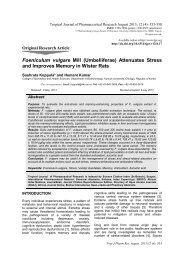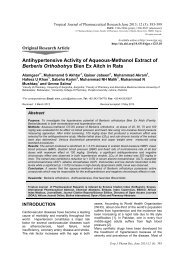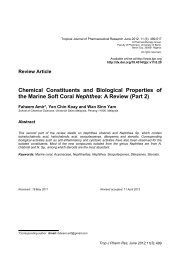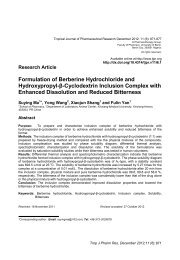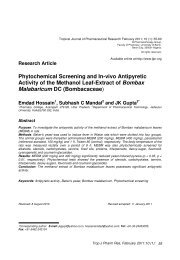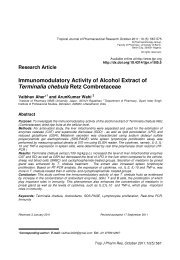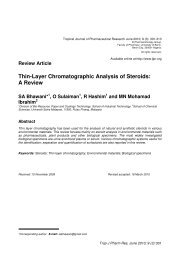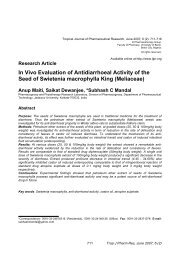Effect of Bridelia ferruginea (Euphorbiaceae) Leaf Extract on ...
Effect of Bridelia ferruginea (Euphorbiaceae) Leaf Extract on ...
Effect of Bridelia ferruginea (Euphorbiaceae) Leaf Extract on ...
Create successful ePaper yourself
Turn your PDF publications into a flip-book with our unique Google optimized e-Paper software.
Research Article<br />
Ezzeldi & Nahhas<br />
Tropical Journal <str<strong>on</strong>g>of</str<strong>on</strong>g> Pharmaceutical Research October 2012; 11 (5): 759-765<br />
© Pharmacotherapy Group,<br />
Faculty <str<strong>on</strong>g>of</str<strong>on</strong>g> Pharmacy, University <str<strong>on</strong>g>of</str<strong>on</strong>g> Benin,<br />
Benin City, 300001 Nigeria.<br />
All rights reserved.<br />
Available <strong>on</strong>line at http://www.tjpr.org<br />
http://dx.doi.org/10.4314/tjpr.v11i5.9<br />
<str<strong>on</strong>g>Effect</str<strong>on</strong>g> <str<strong>on</strong>g>of</str<strong>on</strong>g> <str<strong>on</strong>g>Bridelia</str<strong>on</strong>g> <str<strong>on</strong>g>ferruginea</str<strong>on</strong>g> (<str<strong>on</strong>g>Euphorbiaceae</str<strong>on</strong>g>) <str<strong>on</strong>g>Leaf</str<strong>on</strong>g><br />
<str<strong>on</strong>g>Extract</str<strong>on</strong>g> <strong>on</strong> Sucrose-induced Glucose Intolerance in<br />
Rats<br />
Dieud<strong>on</strong>ne Njamen 1 , Benedicta N Nkeh-Chungag 2 , Emmanuel Tsala 3 ,<br />
Zacharias T Fomum 3 , Jean Claude Mbanya 4 and George F Ngufor 5<br />
1 Department <str<strong>on</strong>g>of</str<strong>on</strong>g> Animal Biology and Physiology, Faculty <str<strong>on</strong>g>of</str<strong>on</strong>g> Science, University <str<strong>on</strong>g>of</str<strong>on</strong>g> Yaounde1, PO Box 812, Yaoundé,<br />
Camero<strong>on</strong>, 2 Department <str<strong>on</strong>g>of</str<strong>on</strong>g> Zoology, Faculty <str<strong>on</strong>g>of</str<strong>on</strong>g> Science, Engineering and Technology, Walter Sisulu University,<br />
Mthatha, 5117, South Africa, 3 Department <str<strong>on</strong>g>of</str<strong>on</strong>g> Organic Chemistry, Faculty <str<strong>on</strong>g>of</str<strong>on</strong>g> Science, University <str<strong>on</strong>g>of</str<strong>on</strong>g> Yaoundé 1, PO<br />
Box 812 Yaoundé, 4 Department <str<strong>on</strong>g>of</str<strong>on</strong>g> Internal Medicine, Faculty <str<strong>on</strong>g>of</str<strong>on</strong>g> Medicine and Biomedical Sciences, University <str<strong>on</strong>g>of</str<strong>on</strong>g><br />
Yaounde1, 5 Department <str<strong>on</strong>g>of</str<strong>on</strong>g> Health, Yaoundé, Camero<strong>on</strong>.<br />
Abstract<br />
Purpose: To evaluate the hypoglycaemic effect <str<strong>on</strong>g>of</str<strong>on</strong>g> the methanol extract <str<strong>on</strong>g>of</str<strong>on</strong>g> <str<strong>on</strong>g>Bridelia</str<strong>on</strong>g> <str<strong>on</strong>g>ferruginea</str<strong>on</strong>g> leaves<br />
(MEBF) <strong>on</strong> sucrose-induced glucose intolerance in rats.<br />
Methods: Male Wistar rats, aged 6 - 7 weeks and weighing 140 - 160 g, were used. The animals were<br />
fed standard rat chow supplemented with 35%, 50% or 65% sucrose for 8 weeks while c<strong>on</strong>trol animals<br />
were fed standard rat chow. The hypoglycaemic effect <str<strong>on</strong>g>of</str<strong>on</strong>g> MEBF and the reference drugs (tolbutamide,<br />
and metformin) in the animals were evaluated following a single dose <str<strong>on</strong>g>of</str<strong>on</strong>g> these drugs and 6-day<br />
treatment. Plasma lipid pr<str<strong>on</strong>g>of</str<strong>on</strong>g>iles were also determined.<br />
Results: Fasting glucose c<strong>on</strong>centrati<strong>on</strong>s ranged from 45 to 70 mg/dl, and the increase was significant in<br />
the sucrose diet groups from week 1. After 2 weeks <strong>on</strong> these diets, oral glucose tolerance test showed<br />
that sucrose feeding significantly impaired glucose homeostasis 1 and 2 hours after a glucose challenge<br />
(76.7 2.0 versus 86.4 8.5 and 66.7 1.4 versus 75.5 3.0, respectively). Fasting blood sugar<br />
levels were significantly (p < 0.05) reduced in sucrose-induced, glucose-intolerant rats after a single<br />
dose <str<strong>on</strong>g>of</str<strong>on</strong>g> MEBF. The extract also significantly reduced blood glucose (from 167 ± 23 mg/dL to 126 ± 5<br />
mg/dL), serum total cholesterol (from 161 ± 20 mg/dL to 93 ± 10 mg/dL) and triglyceride levels (281 ± 25<br />
mg/dL to 228 ± 5 mg/dL) in glucose intolerant rats after 6 days <str<strong>on</strong>g>of</str<strong>on</strong>g> treatment.<br />
C<strong>on</strong>clusi<strong>on</strong>: The methanol leaf extract <str<strong>on</strong>g>of</str<strong>on</strong>g> <str<strong>on</strong>g>Bridelia</str<strong>on</strong>g> <str<strong>on</strong>g>ferruginea</str<strong>on</strong>g> exhibited hypoglycaemic effect in glucoseintolerant<br />
rats.<br />
Keywords: Sucrose-induced, Glucose intolerance, <str<strong>on</strong>g>Bridelia</str<strong>on</strong>g> <str<strong>on</strong>g>ferruginea</str<strong>on</strong>g>, Hypoglycaemia, Metformin,<br />
Tolbutamide.<br />
Received: 10 March 2012 Revised accepted: 12 September 2012<br />
*Corresp<strong>on</strong>ding author: Email: bnkehchungag@wsu.ac.za; Tel/Fax: (+27) 47 502 1989<br />
Trop J Pharm Res, October 2012;11 (5): 759
INTRODUCTION<br />
Diabetes mellitus is <strong>on</strong>e <str<strong>on</strong>g>of</str<strong>on</strong>g> the most comm<strong>on</strong><br />
endocrine and metabolic disorders affecting<br />
over 170 milli<strong>on</strong> people worldwide [1,2].<br />
Insulin resistance is a key phenomen<strong>on</strong> in the<br />
pathogenesis <str<strong>on</strong>g>of</str<strong>on</strong>g> type 2 diabetes and is<br />
usually associated with the obesity, dyslipidaemia<br />
and hypertensi<strong>on</strong>. Insulin resistance,<br />
characterised by hyper-insulinemia, hypertriglyceridemia<br />
and hypertensi<strong>on</strong>, has been<br />
reported in primary normoglycaemic and<br />
normotensive, genetically n<strong>on</strong>-susceptible<br />
Sprague-Dawley rats fed high sucrose or<br />
fructose diets [3,4]. Increased fructose<br />
c<strong>on</strong>sumpti<strong>on</strong>, <strong>on</strong> the other hand, has been<br />
associated with obesity epidemic as well as<br />
metabolic syndrome [5,6]. Fructose-rich and<br />
high fat diets, comm<strong>on</strong>ly c<strong>on</strong>sumed in<br />
emerging urban areas, has been associated<br />
with increased prevalence <str<strong>on</strong>g>of</str<strong>on</strong>g><br />
overweight/obesity and diabetes in these<br />
communities [7].<br />
Am<strong>on</strong>g the many challenges faced by<br />
developing countries in the face <str<strong>on</strong>g>of</str<strong>on</strong>g> rapid<br />
urbanizati<strong>on</strong> is the need for medicati<strong>on</strong>s to<br />
address emerging diseases such as diabetes<br />
mellitus. To address this need, indigineous<br />
knowledge is <str<strong>on</strong>g>of</str<strong>on</strong>g>ten referred to, including the<br />
use <str<strong>on</strong>g>of</str<strong>on</strong>g> extracts from medicinal plants. Several<br />
plant extracts are reported to have<br />
hypoglycaemic effect including <str<strong>on</strong>g>Bridelia</str<strong>on</strong>g><br />
<str<strong>on</strong>g>ferruginea</str<strong>on</strong>g> (<str<strong>on</strong>g>Euphorbiaceae</str<strong>on</strong>g>) [8] - a woody<br />
shrub which grows in the Savannah or rain<br />
forests <str<strong>on</strong>g>of</str<strong>on</strong>g> Africa. Traditi<strong>on</strong>ally, B. <str<strong>on</strong>g>ferruginea</str<strong>on</strong>g><br />
bark extract is used as a milk coagulant,<br />
mouth wash, purgative and vermifuge. It is<br />
also used for the treatment <str<strong>on</strong>g>of</str<strong>on</strong>g> diabetes,<br />
arthritis and boils. <str<strong>on</strong>g>Extract</str<strong>on</strong>g>s <str<strong>on</strong>g>of</str<strong>on</strong>g> the plant have<br />
been shown to have molluscidal effect [9],<br />
antibacterial activity [10], anti-inflammatory<br />
property [11] and hypoglycaemic effect [12].<br />
Several compounds with cytotoxic and<br />
cytostatic activity <strong>on</strong> tumor cell lines, such as<br />
β-peltatin-5-O-β-D-glucopyranoside, deoxypodophyllotoxin<br />
and 5’demethoxy-β-peltatin-<br />
5-O-β-D-glucopyranoside, have been isolated<br />
from B. <str<strong>on</strong>g>ferruginea</str<strong>on</strong>g> [13]; so also is the<br />
biflavanol gallocatechim-[4-O-7]-epigalloca-<br />
Njamen et al<br />
techim [14]. Although this plant extract has<br />
been shown to have hypoglycaemic effect, its<br />
effect has not been studied in sucroseinduced<br />
glucose intolerance. The objective <str<strong>on</strong>g>of</str<strong>on</strong>g><br />
the present study was, therefore, to induce<br />
glucose intolerance in normal Wistar rats<br />
using sucrose loading and to investigate the<br />
hypoglycaemic effect <str<strong>on</strong>g>of</str<strong>on</strong>g> the methanol leaf<br />
extract <str<strong>on</strong>g>of</str<strong>on</strong>g> <str<strong>on</strong>g>Bridelia</str<strong>on</strong>g> <str<strong>on</strong>g>ferruginea</str<strong>on</strong>g> in the rats.<br />
EXPERIMENTAL<br />
Plant material<br />
<str<strong>on</strong>g>Bridelia</str<strong>on</strong>g> <str<strong>on</strong>g>ferruginea</str<strong>on</strong>g> was collected in May 2000<br />
in Yaoundé – Camero<strong>on</strong>. It was identified and<br />
authenticated by Mr Nana, a tax<strong>on</strong>omist at<br />
the Camero<strong>on</strong> Nati<strong>on</strong>al Herbarium in<br />
Yaoundé where a voucher specimen<br />
(32266/HNC) was deposited. Air-dried and<br />
powdered leaves (1 kg) were extracted with<br />
methanol at room temperature for 72 h<br />
followed by evaporati<strong>on</strong> <str<strong>on</strong>g>of</str<strong>on</strong>g> the solvent under<br />
reduced pressure using a Büchi Rota-vapor<br />
(Bioblock, Illkirch-France). A greenish crude<br />
extract (80 g) was obtained, from which test<br />
soluti<strong>on</strong>s <str<strong>on</strong>g>of</str<strong>on</strong>g> the required c<strong>on</strong>centrati<strong>on</strong>s were<br />
prepared in Tween 80/ethanol/water (1:1:10)<br />
for subsequent evaluati<strong>on</strong>.<br />
Drugs<br />
Tolbutamide and metformin, used in these<br />
experiments were obtained from Norvo<br />
Nordisk.<br />
Experimental animals<br />
Six to seven week-old male Wistar rats,<br />
weighing 140 – 160 g, were used in these<br />
experiments. Housing <str<strong>on</strong>g>of</str<strong>on</strong>g> animals and all in<br />
vivo experiments were carried out following<br />
the guidelines <str<strong>on</strong>g>of</str<strong>on</strong>g> the Instituti<strong>on</strong>al Ethics<br />
Committee <str<strong>on</strong>g>of</str<strong>on</strong>g> the Camero<strong>on</strong> Ministry <str<strong>on</strong>g>of</str<strong>on</strong>g><br />
Scientific Research and Technology<br />
Innovati<strong>on</strong>, which has adopted the guidelines<br />
established by the European Uni<strong>on</strong> <strong>on</strong><br />
Animal Care (CEE Council 86/609EEC,<br />
EMBO, 2005) [15].<br />
Trop J Pharm Res, October 2012;11 (5): 760
Inducti<strong>on</strong> <str<strong>on</strong>g>of</str<strong>on</strong>g> glucose intolerance<br />
At the start <str<strong>on</strong>g>of</str<strong>on</strong>g> the experiment, baseline<br />
fasting blood glucose level was determined<br />
for all animals after a 12-h fast. A<br />
spectrophotometer, Hemocue R B-Glucose<br />
Analyser (Angelholm, Sweden), was used to<br />
measure blood glucose levels in whole<br />
capillary blood obtained by puncturing the tail<br />
vein. Animals with normal blood glucose<br />
levels were then randomly allocated to each<br />
<str<strong>on</strong>g>of</str<strong>on</strong>g> four experimental groups (5 rats/group).<br />
The c<strong>on</strong>trol group was fed regular laboratory<br />
rat chow (standard diet) c<strong>on</strong>sisting <str<strong>on</strong>g>of</str<strong>on</strong>g> 58.1 %<br />
wheat flour, 5.8 % corn flour, 7.0 % ground<br />
palm nut extract, 11.6 % ground cott<strong>on</strong> nuts,<br />
5.8 % powdered b<strong>on</strong>e and 11.7 % ground<br />
smoked fish. The other three groups were<br />
placed <strong>on</strong> experimental diets, c<strong>on</strong>sisting <str<strong>on</strong>g>of</str<strong>on</strong>g><br />
the standard diet enriched with 35, 50 or 65<br />
% (w/w) sucrose, respectively (hereafter<br />
referred to as sucrose diets). Blood glucose<br />
levels were determined for all animals weekly<br />
during the 8-week diet period.<br />
Glucose tolerance test<br />
After 2 weeks <strong>on</strong> assigned diets, fasting<br />
blood glucose levels were determined in<br />
c<strong>on</strong>trol and 50 % sucrose-fed animals. These<br />
animals were then orally challenged with 3 g<br />
glucose/kg and fasting blood glucose levels<br />
determined 30 min, 1 and 2 h after glucose<br />
administrati<strong>on</strong>.<br />
Assessment <str<strong>on</strong>g>of</str<strong>on</strong>g> hypoglycaemic effect <str<strong>on</strong>g>of</str<strong>on</strong>g><br />
single dose <str<strong>on</strong>g>of</str<strong>on</strong>g> drugs<br />
Whole capillary blood glucose levels were<br />
determined using a blood glucose<br />
spectrophotometer, after an overnight fast.<br />
Glucose c<strong>on</strong>centrati<strong>on</strong> was measured at time<br />
0 h, i.e., just before administrati<strong>on</strong> <str<strong>on</strong>g>of</str<strong>on</strong>g> the<br />
drugs and then at 30 min intervals for 24 h<br />
after drug administrati<strong>on</strong> to the groups which<br />
received either tolbutamide (50 mg/kg) or 50<br />
mg/kg <str<strong>on</strong>g>of</str<strong>on</strong>g> (MEBF). For the group which<br />
received metformin (38 mg/kg), blood<br />
glucose level was measured after 2, 4, 6, 12,<br />
Njamen et al<br />
18 and 24 h post-treatment. Animals which<br />
received insulin (4 U) were tested before<br />
insulin administrati<strong>on</strong> and also 2 h after<br />
insulin administrati<strong>on</strong>.<br />
Hypoglycemic and lipid-lowering effects<br />
<str<strong>on</strong>g>of</str<strong>on</strong>g> MEBF<br />
The animals which showed glucose<br />
intolerance after the 8-week dietary period<br />
were used for this experiment. Ten <str<strong>on</strong>g>of</str<strong>on</strong>g> these<br />
rats were maintained <strong>on</strong> 50 % sucrose<br />
enriched diet and allocated to <strong>on</strong>e <str<strong>on</strong>g>of</str<strong>on</strong>g> the two<br />
groups - 5 to the c<strong>on</strong>trol group which<br />
received no treatment and 5 to the group<br />
treated daily for 6 days with MEFB (50<br />
mg/kg). Serum glucose c<strong>on</strong>centrati<strong>on</strong>,<br />
triglycerides and total cholesterol were<br />
determined before treatment and after 6 days<br />
<str<strong>on</strong>g>of</str<strong>on</strong>g> treatment after a 12 h fast. Briefly, serum<br />
total cholesterol, HDL cholesterol and<br />
triglycerides levels were measured in animals<br />
enzymatically using Cobas Mira S analyzer<br />
with kits purchased from Biolabo (France).<br />
LDL-choloesterol was calculated from<br />
c<strong>on</strong>centrati<strong>on</strong>s <str<strong>on</strong>g>of</str<strong>on</strong>g> total cholesterol, HDL<br />
cholesterol and triglycerides according to<br />
Friedewald [16].<br />
Measurement <str<strong>on</strong>g>of</str<strong>on</strong>g> insulin secreti<strong>on</strong><br />
Pancreatic islet cells from NMRI mice<br />
(Charles River, Sulzfeld, Germany) were<br />
used for these experiments. Mice were<br />
sacrificed by inhalati<strong>on</strong> <str<strong>on</strong>g>of</str<strong>on</strong>g> excess CO2 and<br />
batches <str<strong>on</strong>g>of</str<strong>on</strong>g> 5 pancreatic islets isolated<br />
microscopically and incubated for 60 min at<br />
37 °C with 3 or 15 mM glucose. The<br />
incubati<strong>on</strong> medium (pH 7.4) c<strong>on</strong>tained (in<br />
mMol/l): 122 NaCl, 4.8 KCl, 2.5 CaCl2, 1.1<br />
MgCl2, 10 (4-(2-Hydroxyethyl)piperazine-1ethanesulf<strong>on</strong>ic<br />
acid (HEPES), as well as 0.5<br />
% bovine serum albumin. The plant extract<br />
was added at different c<strong>on</strong>centrati<strong>on</strong>s in the<br />
presence <str<strong>on</strong>g>of</str<strong>on</strong>g> 3 or 15 mM glucose. The amount<br />
<str<strong>on</strong>g>of</str<strong>on</strong>g> insulin secreted was determined by<br />
radioimmunoassay using rat insulin (Crystal<br />
Chem. Inc., USA) as standard.<br />
Trop J Pharm Res, October 2012;11 (5): 761
Statistical analysis<br />
GraphPad Instat was used to carry out <strong>on</strong>eway<br />
analysis <str<strong>on</strong>g>of</str<strong>on</strong>g> variance (ANOVA) followed<br />
by Tukey-Kramer Multiple Comparis<strong>on</strong>s Test.<br />
For data <strong>on</strong> insulin secreti<strong>on</strong>, multiple<br />
comparis<strong>on</strong>s were made by ANOVA followed<br />
by Student-Newman-Keuls test. The results<br />
are expressed as mean ± standard error. A pvalue<br />
<str<strong>on</strong>g>of</str<strong>on</strong>g> < 0.05 was c<strong>on</strong>sidered significant.<br />
RESULTS<br />
<str<strong>on</strong>g>Effect</str<strong>on</strong>g> <str<strong>on</strong>g>of</str<strong>on</strong>g> diet <strong>on</strong> glucose tolerance<br />
Baseline fasting blood glucose levels in<br />
normoglycemic rats were between 45 - 52<br />
mg/dL. Sucrose diets induced significant<br />
increases in the mean blood glucose<br />
c<strong>on</strong>centrati<strong>on</strong>. Animals fed 35% and 50%<br />
sucrose showed significant (p
Njamen et al<br />
Table 3: Hypoglycaemic effect <str<strong>on</strong>g>of</str<strong>on</strong>g> porcine insulin (4 U/rat, s.c.) in 50 % sucrose-fed and c<strong>on</strong>trol rats after 12<br />
h <str<strong>on</strong>g>of</str<strong>on</strong>g> fasting<br />
Time C<strong>on</strong>trol Sucrose fed rats<br />
(h)<br />
Blood glucose<br />
(mg/dL)<br />
Reducti<strong>on</strong> in blood<br />
glucose (%)<br />
Blood glucose<br />
(mg/dL)<br />
Reducti<strong>on</strong> in blood<br />
glucose (%)<br />
0 46.7 1.4 - 73.3 4.0* -<br />
2 16.7 0.3* 64.5 35.0 0.1* 52.3<br />
*p < 0.05, n = 5<br />
fed standard diet (Fig 2a). Total serum<br />
cholesterol level was significantly higher (p <<br />
0.05) in sucrose-fed rats than in c<strong>on</strong>trol rats,<br />
while serum triglyceride levels were 280.7 <br />
23.1 and 169 17.1 mg/dL (p < 0.05) in 50 %<br />
sucrose-fed and c<strong>on</strong>trol rats, respectively.<br />
The 50 % sucrose diet significantly (p < 0.05)<br />
increased blood glucose, serum triglyceride<br />
and total cholesterol levels<br />
Fig 1: Hypoglycaemic effect <str<strong>on</strong>g>of</str<strong>on</strong>g> MEBF, tolbutamide<br />
and metformin in 50% sucrose-fed rats after an<br />
overnight fast; * p < 0.05 compared to c<strong>on</strong>trol, n =<br />
5.<br />
<str<strong>on</strong>g>Effect</str<strong>on</strong>g> <str<strong>on</strong>g>of</str<strong>on</strong>g> 6-day treatment with MEBF <strong>on</strong><br />
blood glucose and lipid levels<br />
After 6 days <str<strong>on</strong>g>of</str<strong>on</strong>g> oral MEBF treatment (50<br />
mg/kg/day), fasting blood glucose levels in 50<br />
% sucrose-fed rats decreased significantly (p<br />
< 0.05) to levels similar to those observed in<br />
c<strong>on</strong>trol animals (126.4 ± 2.9 versus 167.7<br />
mg/dL ± 13 for c<strong>on</strong>trol). Sucrose-fed rats<br />
treated with MEBF significantly (p < 0.05)<br />
reduced serum triglyceride and total<br />
cholesterol relative to c<strong>on</strong>trol values.<br />
Although both triglyceride and total<br />
cholesterol levels were significantly reduced<br />
by MEBF, post-treatment levels were not<br />
different from pre-treatment levels in c<strong>on</strong>trol<br />
animals (Fig 2b).<br />
(a)<br />
(b)<br />
Fig 2: (a) <str<strong>on</strong>g>Effect</str<strong>on</strong>g> <str<strong>on</strong>g>of</str<strong>on</strong>g> sucrose-enriched diet <strong>on</strong> blood<br />
glucose, triglyceride and total cholesterol levels <str<strong>on</strong>g>of</str<strong>on</strong>g><br />
rats after 8 weeks <strong>on</strong> 50 % sucrose diet; (b) <str<strong>on</strong>g>Effect</str<strong>on</strong>g> <str<strong>on</strong>g>of</str<strong>on</strong>g><br />
6-day MEBF treatment <strong>on</strong> fasting blood glucose<br />
level, serum triglyceride and serum total cholesterol<br />
levels in 50 % sucrose-fed animals, compared to<br />
c<strong>on</strong>trol animals; *p < 0.05, **p < 0.01, n= 5.<br />
Trop J Pharm Res, October 2012;11 (5): 763
<str<strong>on</strong>g>Effect</str<strong>on</strong>g> <str<strong>on</strong>g>of</str<strong>on</strong>g> MEBF extract <strong>on</strong> insulin<br />
secreti<strong>on</strong><br />
MEBF, at all dose levels tested, did not<br />
induce any significant effect (p < 0.05) <strong>on</strong><br />
insulin secreti<strong>on</strong>.<br />
DISCUSSION<br />
The results presented dem<strong>on</strong>strate that rats<br />
fed sucrose-rich diets for 8 weeks developed<br />
higher fasting blood glucose c<strong>on</strong>centrati<strong>on</strong>s.<br />
After 2 weeks <str<strong>on</strong>g>of</str<strong>on</strong>g> ingesting sucrose-enriched<br />
diet, the rats showed intolerance to glucose<br />
as indicated by the oral glucose tolerance<br />
test. Blood glucose levels were significantly<br />
higher from the 5 th week <str<strong>on</strong>g>of</str<strong>on</strong>g> sucrose enriched<br />
diet, indicating that the impairment <str<strong>on</strong>g>of</str<strong>on</strong>g> glucose<br />
homeostasis is dependent <strong>on</strong> the durati<strong>on</strong> <str<strong>on</strong>g>of</str<strong>on</strong>g><br />
exposure to large amounts <str<strong>on</strong>g>of</str<strong>on</strong>g> sucrose.<br />
When sucrose is c<strong>on</strong>sumed, it is broken<br />
down to glucose and fructose. Absorbed<br />
fructose is c<strong>on</strong>verted to lipogenic precursors<br />
leading to increase in plasma triglyceride<br />
levels [17,18]. Our results show that at the<br />
end <str<strong>on</strong>g>of</str<strong>on</strong>g> the 8-week diet period, total<br />
cholesterol and triglyceride levels were<br />
significantly higher in sucrose-fed rats,<br />
compared to c<strong>on</strong>trol. High fructose diets are<br />
associated with increased serum triglyceride<br />
[19] and total cholesterol [18] levels. L<strong>on</strong>gterm<br />
effects <str<strong>on</strong>g>of</str<strong>on</strong>g> fructose administrati<strong>on</strong> include<br />
significant lipotoxicity and hepatic insulin<br />
resistance which may eventually lead to a<br />
more generalized insulin resistance [20,21];<br />
this was reflected by the significantly higher<br />
blood glucose levels in sucrose-fed animals.<br />
Unlike glucose, fructose does not induce the<br />
release <str<strong>on</strong>g>of</str<strong>on</strong>g> insulin or leptin, both <str<strong>on</strong>g>of</str<strong>on</strong>g> which are<br />
necessary for glucose handling [19].<br />
Importantly, Wei et al [22] reported that<br />
fructose administrati<strong>on</strong> may cause oxidative<br />
stress leading to the release <str<strong>on</strong>g>of</str<strong>on</strong>g> reactive<br />
oxygen species which, in turn, may be<br />
associated with impaired insulin signalling.<br />
This observati<strong>on</strong> is in agreement with our<br />
findings which show that sucrose-fed rats had<br />
higher blood glucose levels when challenged<br />
Njamen et al<br />
with oral glucose, indicating impairment in<br />
glucose handling mechanisms. The<br />
administrati<strong>on</strong> <str<strong>on</strong>g>of</str<strong>on</strong>g> insulin to sucrose-fed rats<br />
induced a smaller glucose lowering effect<br />
compared to c<strong>on</strong>trol, suggesting that the<br />
sucrose-fed rats had developed impaired<br />
resp<strong>on</strong>se to insulin acti<strong>on</strong>. C<strong>on</strong>sistent with<br />
this observati<strong>on</strong>, metformin, which acts by<br />
increasing insulin-mediated glucose uptake<br />
by cells [23], failed to show significant<br />
hypoglycaemic activity in sucrose-fed animals<br />
until 18 h post-metformin administrati<strong>on</strong>.<br />
MEBF extract exhibited significant<br />
hypoglycaemic activity in sucrose-fed,<br />
glucose-intolerant rats compared to c<strong>on</strong>trol<br />
rats, indicating that this extract may c<strong>on</strong>tain<br />
metabolites with anti-diabetic properties.<br />
Cholesterol as well as triglyceride levels were<br />
also decreased in these rats compared to<br />
untreated animals. These two observati<strong>on</strong>s<br />
suggest that B. <str<strong>on</strong>g>ferruginea</str<strong>on</strong>g> leaf extract lowers<br />
blood glucose c<strong>on</strong>centrati<strong>on</strong> by improving<br />
insulin sensitivity and not by stimulating<br />
insulin secreti<strong>on</strong>.<br />
CONCLUSION<br />
The leaf extract <str<strong>on</strong>g>of</str<strong>on</strong>g> <str<strong>on</strong>g>Bridelia</str<strong>on</strong>g> <str<strong>on</strong>g>ferruginea</str<strong>on</strong>g><br />
exhibited hypoglycaemic effects in sucroseinduced<br />
glucose intolerant rats as well as<br />
improved lipid pr<str<strong>on</strong>g>of</str<strong>on</strong>g>iles. However, further<br />
studies are required to ascertain if these<br />
findings can be translated to applicati<strong>on</strong>s.<br />
ACKNOWLEDGEMENT<br />
This work was supported by the IFS/OPCW<br />
(grant no. F/3336-1 to Dr Njamen) and the<br />
Walter Sisulu Instituti<strong>on</strong>al Research Fund.<br />
We wish to thank Mr Nana Victor (Nati<strong>on</strong>al<br />
Herbarium, Yaoundé - Camero<strong>on</strong>) for his<br />
assistance with ethnobotanical survey and<br />
collecti<strong>on</strong> <str<strong>on</strong>g>of</str<strong>on</strong>g> the plant material.<br />
REFERENCES<br />
1. Wild S, Roglic G, Green A, Sicree R, King H. Global<br />
prevalence <str<strong>on</strong>g>of</str<strong>on</strong>g> diabetes: estimates for the year<br />
2000 and projecti<strong>on</strong>s for 2030. Diabetes Care<br />
2004; 27: 1047-1053.<br />
Trop J Pharm Res, October 2012;11 (5): 764
2. Kumar S, Narwal S, Kumar V, Prakash O.<br />
Glucosidase inhibitors from plants: a natural<br />
approach to treat diabetes. Pharmacogn Rev<br />
2011; 5: 19-29.<br />
3. Huang BW, Chiang MT, Yao HT and Chiang W.<br />
The effect <str<strong>on</strong>g>of</str<strong>on</strong>g> high-fat and high-fructose diets<br />
<strong>on</strong> glucose tolerance and plasma lipid and<br />
leptin levels in rats. Diabetes Obes Metab<br />
2004; 6: 120-126.<br />
4. Or<strong>on</strong>-Herman M, Kamari Y, Grossman E, Yeger H,<br />
Peleg E, Shabtay Z, Shamiss A, Sharabi Y.<br />
Metabolic syndrome: comparis<strong>on</strong> <str<strong>on</strong>g>of</str<strong>on</strong>g> the two<br />
comm<strong>on</strong>ly used animal models. Am J<br />
Hypertens 2008; 21: 1019-1022.<br />
5. Elliott SS, Keim NL, Stern JS, Teff K, Havel PJ.<br />
Fructose, weight gain, and the insulin<br />
resistance syndrome. Am J Clin Nutr 2002; 7:<br />
911-922.<br />
6. Bray GA, Nielsen SJ, Popkin BM. C<strong>on</strong>sumpti<strong>on</strong> <str<strong>on</strong>g>of</str<strong>on</strong>g><br />
high-fructose corn syrup in beverages may<br />
play a role in the epidemic <str<strong>on</strong>g>of</str<strong>on</strong>g> obesity. Am J<br />
Clin Nutr 2004; 7 9: 537-543.<br />
7. Hu FB. Globalizati<strong>on</strong> <str<strong>on</strong>g>of</str<strong>on</strong>g> diabetes – The role <str<strong>on</strong>g>of</str<strong>on</strong>g> diet,<br />
lifestyle and genes. Diabetes Care 2011; 34:<br />
1249-1257.<br />
8. Amp<str<strong>on</strong>g>of</str<strong>on</strong>g>o O. The practice <str<strong>on</strong>g>of</str<strong>on</strong>g> phytotherapy in Ghana.<br />
In: S<str<strong>on</strong>g>of</str<strong>on</strong>g>owora EA (Ed.) African Medicinal<br />
Plants. University <str<strong>on</strong>g>of</str<strong>on</strong>g> Ife Press, Ile-Ife, 1979; p<br />
67.<br />
9. Iwu MM. Anti-diabetic properties <str<strong>on</strong>g>of</str<strong>on</strong>g> <str<strong>on</strong>g>Bridelia</str<strong>on</strong>g><br />
<str<strong>on</strong>g>ferruginea</str<strong>on</strong>g> leaves. Planta Medica 1980; 39:<br />
247.<br />
10. Talla E, Njamen D, Djoulde DR, Tatsadjeu L,<br />
Tantoh D, Mbafor JT, Fomum ZT Antimicrobial<br />
activity <str<strong>on</strong>g>of</str<strong>on</strong>g> <str<strong>on</strong>g>Bridelia</str<strong>on</strong>g> <str<strong>on</strong>g>ferruginea</str<strong>on</strong>g> leaves<br />
extracts. Fitoterapia 2002; 73: 343-345.<br />
11. Olajide OA, Makinde JM, Okpako DT, Awe SO.<br />
Studies <strong>on</strong> the anti-inflammatory and related<br />
pharmacological properties <str<strong>on</strong>g>of</str<strong>on</strong>g> the aqueous<br />
extract <str<strong>on</strong>g>of</str<strong>on</strong>g> <str<strong>on</strong>g>Bridelia</str<strong>on</strong>g> <str<strong>on</strong>g>ferruginea</str<strong>on</strong>g> stem bark. J<br />
Ethnopharmacol 2000; 71: 153-160.<br />
12. Onunkwo GC, Akah PA, Udeala OK. Studies <strong>on</strong><br />
<str<strong>on</strong>g>Bridelia</str<strong>on</strong>g> <str<strong>on</strong>g>ferruginea</str<strong>on</strong>g> leaves. Stability and<br />
hypoglycemic acti<strong>on</strong>s <str<strong>on</strong>g>of</str<strong>on</strong>g> the leaf extract<br />
tablets. Phytopther Res 1996; 10: 418-420.<br />
13. Rashid MA, Gustafs<strong>on</strong> KR, cardelina JH, Boyd MR.<br />
A new podophyllotoxin derivative from <str<strong>on</strong>g>Bridelia</str<strong>on</strong>g><br />
<str<strong>on</strong>g>ferruginea</str<strong>on</strong>g>. Nat Prod Lett 2000; 14: 285-292.<br />
14. Cimanga K, Ying L, De Bruyne T, Apers S, Cos P,<br />
Hermans, Bakana P, T<strong>on</strong>a L, Kambu K,<br />
Kalenda DT, Pieters L, Berghe DV, Vlietinck<br />
Njamen et al<br />
AJ. Radical scavenging and xanthine oxidase<br />
inhibitory activity <str<strong>on</strong>g>of</str<strong>on</strong>g> phenolic compounds from<br />
<str<strong>on</strong>g>Bridelia</str<strong>on</strong>g> <str<strong>on</strong>g>ferruginea</str<strong>on</strong>g> stem bark. J Pharm &<br />
Pharmacol 2001; 53: 757-761.<br />
15. EMBO (European Molecular Biological<br />
Organizati<strong>on</strong>. Revisi<strong>on</strong> <str<strong>on</strong>g>of</str<strong>on</strong>g> the EC directive <strong>on</strong><br />
the welfare <str<strong>on</strong>g>of</str<strong>on</strong>g> research animals – An advance<br />
briefing 2005. [cited 2011 Feb 27]. Available<br />
from: http://www.informatiedierproeven.nl/files/<br />
pdf/Artikelen/Animals%20EC%20directive%20<br />
B8.pdf<br />
16. Friedewald WT, Levy RI, Freidricks<strong>on</strong> DS.<br />
Estimati<strong>on</strong> <str<strong>on</strong>g>of</str<strong>on</strong>g> the c<strong>on</strong>centrati<strong>on</strong> <str<strong>on</strong>g>of</str<strong>on</strong>g> low-density<br />
lipoprotein in plasma, without use <str<strong>on</strong>g>of</str<strong>on</strong>g><br />
preparative ultracentrifuge. Clin Chem 1927;<br />
18: 499-502<br />
17. Dekker MJ, Su Q, Baker C, Rutledge AC, Adeli K.<br />
Fructose: a highly lipogenic nutrient implicated<br />
in insulin resistance, hepatic steatosis and the<br />
metabolic syndrome. Am J Physiol Endocrinol<br />
Metab 2010; 299: E685-E694.<br />
18. Ch<strong>on</strong>g MF, Fielding BA, Frayn KN. Mechanisms for<br />
the acute effect <str<strong>on</strong>g>of</str<strong>on</strong>g> fructose <strong>on</strong> postprandial<br />
lipemia. Am J Clin Nutr 2007; 85: 1511-1520.<br />
19. Stanhope KL, Havel P. Endocrine and metabolic<br />
effects <str<strong>on</strong>g>of</str<strong>on</strong>g> c<strong>on</strong>suming beverages sweetened<br />
with fructose, glucose, sucrose or highfructose<br />
corn syrup. Am J Clin Nutr 2008; 88:<br />
17335-17375.<br />
20. Tappy L, Lê KA. Metabolic effects <str<strong>on</strong>g>of</str<strong>on</strong>g> sweetened<br />
beverages: pathophysiology and mechanistic<br />
insights. Off J Inter Chair Cardiometab Risk<br />
2010; 3: 13-18.<br />
21. Stanhope KL, Schwarz JM, Keim NL, Griffen SC,<br />
Bremer AA, Graham JL, Hattcher B, Cox CL,<br />
Dyachenko A, Zhang W et al. C<strong>on</strong>suming<br />
fructose-sweetened, not glucose-sweetened<br />
beverages increases visceral adiposity and<br />
lipids and decreases insulin sensitivity in<br />
overweight/obese humans. J Clin Invest 2009;<br />
119: 1322–1334.<br />
22. Wei Y, Wang D, Pagliassotti MJ. Fructose<br />
selectively modulates c-jun N-terminal kinase<br />
activity and insulin signaling in rat primary<br />
hepatocytes. J Nutr 2005; 135: 1642-1646.<br />
23. Parakhia RA, Ouyang J, Ochs RS. A new<br />
mechanism <str<strong>on</strong>g>of</str<strong>on</strong>g> acti<strong>on</strong> for metformin. FASEBJ<br />
2009; 23: suppl. 856.16.<br />
Trop J Pharm Res, October 2012;11 (5): 765



